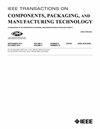Optimization of the Wire Bonding Process for Enhanced Thermomechanical Performance of Quad Flat No-Lead (QFN) Packages in Automotive Applications
IF 3
3区 工程技术
Q2 ENGINEERING, ELECTRICAL & ELECTRONIC
IEEE Transactions on Components, Packaging and Manufacturing Technology
Pub Date : 2025-04-22
DOI:10.1109/TCPMT.2025.3563367
引用次数: 0
Abstract
This study investigates how local warpage and stress near the sawing lines of quad flat no-lead (QFN) packages, under stringent automotive conditions, influence the wire bonding process. A finite element model, validated through experimental measurements, was developed to quantify deformation and stress distributions along the cutting paths. Three lead frame strip designs—one row one block, multiblock, and one block—were comparatively assessed under both thermal and mechanical loads. Results show that the one row one block design can reduce local deformation by up to 70%–75% (e.g.,优化线键合工艺以提高汽车应用中四平无铅封装的热机械性能
本研究探讨了在严格的汽车条件下,四平无铅(QFN)封装的锯线附近的局部翘曲和应力如何影响线键合过程。通过实验测量验证的有限元模型可以量化沿切割路径的变形和应力分布。三种引线框架条设计——单排、单块、多块和单块——在热负荷和机械负荷下进行了比较评估。结果表明,与单块配置相比,一行一块设计可以减少高达70%-75%的局部变形(例如,$45~\mu $ m对$159~\mu $ m),显着降低了对准误差和疲劳风险。同时,其峰值局部应力约为212 MPa,相对于单个区块设计的708 MPa降低了70%。这些综合改进突出了锯切区域平衡结构设计的必要性,以提高焊丝粘合的稳定性。总的来说,这些发现为在严格的汽车条件下优化QFN封装提供了一个强大的框架,特别是通过改进线键合设计。
本文章由计算机程序翻译,如有差异,请以英文原文为准。
求助全文
约1分钟内获得全文
求助全文
来源期刊

IEEE Transactions on Components, Packaging and Manufacturing Technology
ENGINEERING, MANUFACTURING-ENGINEERING, ELECTRICAL & ELECTRONIC
CiteScore
4.70
自引率
13.60%
发文量
203
审稿时长
3 months
期刊介绍:
IEEE Transactions on Components, Packaging, and Manufacturing Technology publishes research and application articles on modeling, design, building blocks, technical infrastructure, and analysis underpinning electronic, photonic and MEMS packaging, in addition to new developments in passive components, electrical contacts and connectors, thermal management, and device reliability; as well as the manufacture of electronics parts and assemblies, with broad coverage of design, factory modeling, assembly methods, quality, product robustness, and design-for-environment.
 求助内容:
求助内容: 应助结果提醒方式:
应助结果提醒方式:


